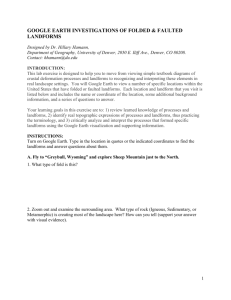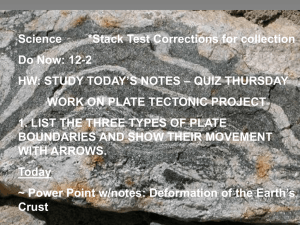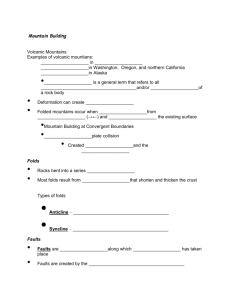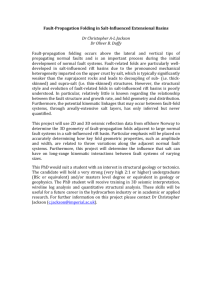Lab 3: Faults, Folds and Sedimentary Rock ID
advertisement
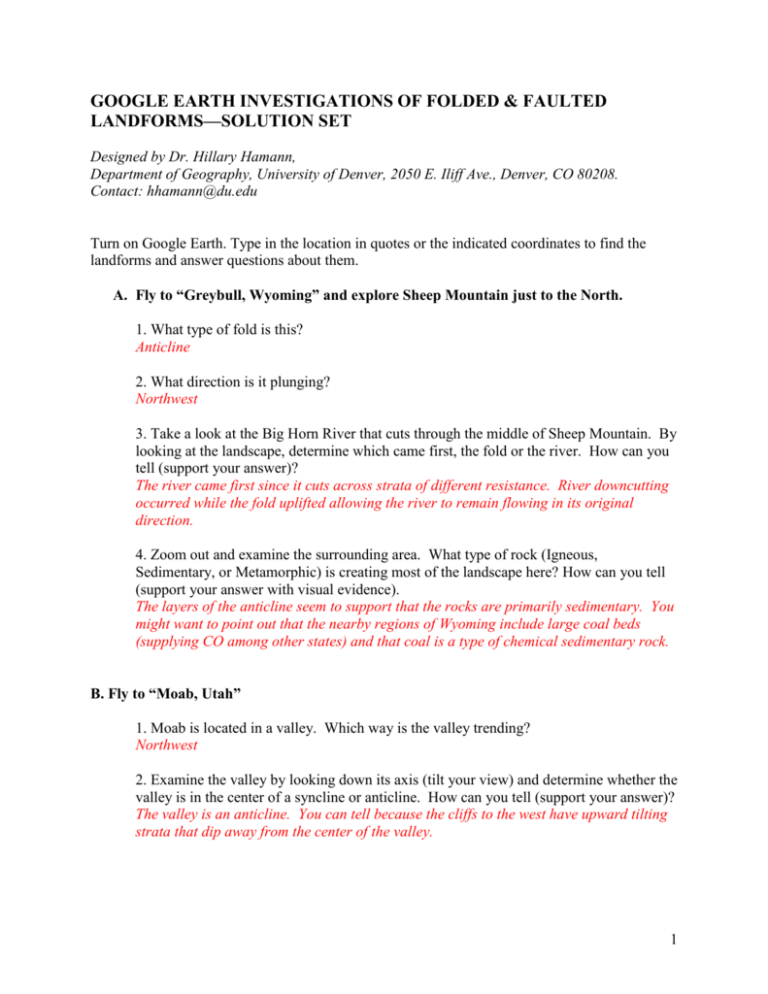
GOOGLE EARTH INVESTIGATIONS OF FOLDED & FAULTED LANDFORMS—SOLUTION SET Designed by Dr. Hillary Hamann, Department of Geography, University of Denver, 2050 E. Iliff Ave., Denver, CO 80208. Contact: hhamann@du.edu Turn on Google Earth. Type in the location in quotes or the indicated coordinates to find the landforms and answer questions about them. A. Fly to “Greybull, Wyoming” and explore Sheep Mountain just to the North. 1. What type of fold is this? Anticline 2. What direction is it plunging? Northwest 3. Take a look at the Big Horn River that cuts through the middle of Sheep Mountain. By looking at the landscape, determine which came first, the fold or the river. How can you tell (support your answer)? The river came first since it cuts across strata of different resistance. River downcutting occurred while the fold uplifted allowing the river to remain flowing in its original direction. 4. Zoom out and examine the surrounding area. What type of rock (Igneous, Sedimentary, or Metamorphic) is creating most of the landscape here? How can you tell (support your answer with visual evidence). The layers of the anticline seem to support that the rocks are primarily sedimentary. You might want to point out that the nearby regions of Wyoming include large coal beds (supplying CO among other states) and that coal is a type of chemical sedimentary rock. B. Fly to “Moab, Utah” 1. Moab is located in a valley. Which way is the valley trending? Northwest 2. Examine the valley by looking down its axis (tilt your view) and determine whether the valley is in the center of a syncline or anticline. How can you tell (support your answer)? The valley is an anticline. You can tell because the cliffs to the west have upward tilting strata that dip away from the center of the valley. 1 3. Zoom out a little (from a top view) and you should be able to see at least two similartrending structures to the N-NE of the Moab Valley. Find these and zoom in enough to identify at least one of them. What is it called? Castle Valley is the southern of the two anticline valleys and Arches National Park is the more northern one just to the northeast of Moab. The area around Moab, UT is known as the Colorado Plateau and has alternately been bounded by eroding mountains, covered with shallow inland seas and beaches, and the site of a Saharalike sand desert covered with dunes. As the seas evaporated, they left behind large evaporite deposits including precipitated limestone, gypsum and salt. When under high confining pressure, for example if it is buried deeply under other sedimentary rocks, rock salt flows like wet putty or glacial ice toward areas of lower pressure. The salt can flow laterally or vertically until it encounters an area of less pressure such as a fault. Topographic bulges (anticlines or domes known as “diapirs”) can develop where salt flowage lifts overlying strata. Groundwater can dissolve the uppermost salt over time and undermine the overlying strata. C. Fly to the coordinates: 38°26’12.21”N, 109°55’46.65”W (remember to leave a space instead of typing the deg symbol), just to the SW of Moab and between the Green and Colorado Rivers in Canyonlands National Park. Zoom out enough so that you can see the feature. 1. Describe this feature The feature is round and various strata are exposed showing the center to be eroded out. There is a stream exiting the dome to the NW. 2. What is this feature called? A Dome, specifically a Salt Diapir 3. Think about the geologic history of the area and the types of sediments/evaporites that you find and try to describe how the Moab Valley, the folded structures from question B.3. and the feature you are looking at formed. Salt evaporates flowed to areas of weakness (such as faults) and bowed up the anticlines of Moab/Castle Valley/Arches and the Diapir. Groundwater dissolved the upper layers of salt and caused the overlying strata to collapse. River erosion eventually transported the rock away leaving a valley or collapsed dome. D. Fly to Crescent Valley, Nevada. The Cortez Mountains are the range to the south of Crescent Valley. 1. Describe the contact between the valley and the Cortez Mountains. The contact is very abrupt between the flat valley and the mountains. It is somewhat curvy. 2. Which way are the mountains trending? 2 The mountains trend NE-SW 3. Zoom to an eye altitude of about 35-40 miles and turn on the Google Earth layer that marks places of interest. You should see at least two or three bullet marks along the Cortez Mountains. What do these bullets show (click on bullet for information)? Shallow earthquakes of magnitudes of about 4.3 4. What do these combinations of observations suggest is the process that formed the Cortez Mountains? Faulting Rotate and tilt your view so that you are looking straight on the Cortez mountains that bound the S-SW part of the valley. Looking up and down the mountain front you will notice that the mountain ridges perpendicular to the mountain front look like they’ve been lopped off leaving triangular shaped faces. These are called “triangular facets.” 1. Study these facets and determine what type of fault you are looking at. How can you tell? The fault is a normal fault. The facet indicates that the valley dropped down relative to the mountains. 2. What type of stress causes this fault? Extension The Cortez mountains are a part of the Basin and Range region that extends from eastern California across most of Nevada to Western Utah. Zoom out and look at the Basin and Range area. 3. With your knowledge of the Basin and Range geography and formation, what is another appropriate term that can be used to describe the Crescent Valley? Graben 4. What is another appropriate term to describe the Cortez Mountain Range? Horst E. Finally, let’s take a look at the San Andreas Fault in California. Fly to 35°06’45.87”N, 119°38’40.63”W. This is the Elkhorn Scarp area east of San Luis Obispo, CA, and the site of the often used photo of the fault. 1. Zoom out to about 10 miles and observe the fault. Which way is the fault trending? NW-SE 2. As you know from class, the San Andreas Fault is a classic example of what type of fault? Strike-slip fault 3 3. Scan back and forth across the fault near the Elkhorn Scarp and note that many rivers are flowing from the mountains in the NE toward the SW. Also note that many of these rivers become offset along the fault. This offset can tell you the relative motion of the fault. What is it and how do you know? The fault is a right lateral fault. You know because standing on one side, eg. the downstream portion of the river, and looking across the fault, the upstream portion of the river is offset to the right. 4
